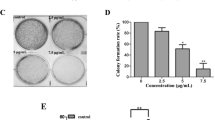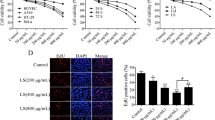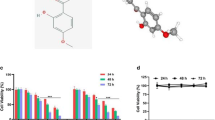Abstract
Dimethylfumarate (DMF) is cytotoxic to several kinds of cells and serves as an anti-tumor drug. This study was designed to investigate the effects and underlying mechanism of DMF on cervical cancer cells. HeLa cells were cultured and treated with 0, 50, 100, 150, and 200 μM DMF, respectively. After 24 h, cell growth was evaluated using Cell Counting Kit-8 (CCK-8) assay and the cell cycle was examined using flow cytometry. In addition, cell apoptosis was detected by Annexin V/propidium iodide (PI) staining and the expressions of caspase-3 and poly-ADP-ribose polymerase (PARP) were detected using western blotting. The redox-related factors were then assessed. Furthermore, all of the indicators were detected in HeLa cells after combined treatment of DMF and N-acetyl-l-cysteine (NAC, an oxygen-free radical scavenger). The cell number and cell growth of HeLa were obviously inhibited by DMF in a dose-dependent manner, as the cell cycle was arrested at G0/G1 phase (P < 0.05). The apoptotic HeLa cells were markedly increased, and the expression levels of caspase-3 and PARP were significantly increased in a DMF concentration-dependent way (P < 0.05). Meanwhile, loss of △Ψm, increase in reactive oxygen species and O2 ·−, and the decrease in catalase activity and glutathione (GSH) level were found after DMF treatment (P < 0.05). All these changes were significantly attenuated and even completely disappeared by adding NAC (P < 0.05). In conclusion, the cytotoxicity of DMF on cell proliferation and apoptosis of HeLa cells was mainly related to the intracellular redox systems by depletion of intracellular GSH.






Similar content being viewed by others
References
Aneja P, Rahman M, Beg S, Aneja S, Dhingra V, Chugh R (2013) Cancer targeted magic bullets for effective treatment of cancer. Recent Pat Antiinfect Drug Discov 9:121–135
Arnold P, Mojumder D, DeToledo J, Lucius R, Wilms H (2014) Pathophysiological processes in multiple sclerosis: focus on nuclear factor erythroid-2-related factor 2 and emerging pathways. Clinical Pharmacology: Advances and Applications 6:35–42
Boivin A, Hanot M, Malesys C, Maalouf M, Rousson R, Rodriguez-Lafrasse C, Ardail D (2011) Transient alteration of cellular redox buffering before irradiation triggers apoptosis in head and neck carcinoma stem and non-stem cells. PLoS One 6:e14558
Chen Q, Luo Z-Y, Lin M, Lin Q-L, Chen C-Y, Yang C, Xie L-X, Li H, Zheng J-K, Yang L-Y (2012) Prevalence and genotype distribution of human papillomavirus infections in women attending hospitals in Chaozhou of Guangdong Province. Asian Pac J Cancer Prev 13:1519–1524
Chen T-J, Jeng J-Y, Lin C-W, Wu C-Y, Chen Y-C (2006) Quercetin inhibition of ROS-dependent and-independent apoptosis in rat glioma C6 cells. Toxicology 223:113–126
Dethlefsen L, Lehman C, Biaglow J, Peck V (1988) Toxic effects of acute glutathione depletion by buthionine sulfoximine and dimethylfumarate on murine mammary carcinoma cells. Radiat Res 114:215–224
Devadas S, Hinshaw JA, Zaritskaya L, Williams MS (2003) Fas-stimulated generation of reactive oxygen species or exogenous oxidative stress sensitize cells to Fas-mediated apoptosis. Free Radic Biol Med 35:648–661
Ding X, Wang D, Li L, Ma H (2016) Dehydroepiandrosterone ameliorates H2O2-induced Leydig cells oxidation damage and apoptosis through inhibition of ROS production and activation of PI3K/Akt pathways. Int J Biochem Cell Biol 70:126–139
Dizon DS, Group TCCSI (2013) Pushing the bar in treatment of cervical cancer: what can comprehensive cancer centers do on their own? Gynecol Oncol 131:464–466
Estrela JM, Ortega A, Obrador E (2006) Glutathione in cancer biology and therapy. Crit Rev Clin Lab Sci 43:143–181
García-Caballero M, Marí-Beffa M, Medina MÁ, Quesada AR (2011) Dimethylfumarate inhibits angiogenesis in vitro and in vivo: a possible role for its antipsoriatic effect. J Investig Dermatol 131:1347–1355
Gerhardt S, Konig V, Doll M, Hailemariam-Jahn T, Hrgovic I, Zoller N, Kaufmann R, Kippenberger S, Meissner M (2015) Dimethylfumarate protects against TNF-alpha-induced secretion of inflammatory cytokines in human endothelial cells. Journal of Inflammation (London, England) 12:49
Ghoreschi K, Brück J, Kellerer C, Deng C, Peng H, Rothfuss O, Hussain RZ, Gocke AR, Respa A, Glocova I (2011) Fumarates improve psoriasis and multiple sclerosis by inducing type II dendritic cells. J Exp Med 208:2291–2303
Ghose S, Holloway L, Lim K, Chan P, Veera J, Vinod SK, Liney G, Greer PB, Dowling J (2015) A review of segmentation and deformable registration methods applied to adaptive cervical cancer radiation therapy treatment planning. Artif Intell Med 64:75–87
Han YH, Kim SZ, Kim SH, Park WH (2008) Apoptosis in pyrogallol-treated Calu-6 cells is correlated with the changes of intracellular GSH levels rather than ROS levels. Lung Cancer 59:301–314
Higuchi Y (2004) Glutathione depletion-induced chromosomal DNA fragmentation associated with apoptosis and necrosis. J Cell Mol Med 8:455–464
Hrgovic I, Valesky E, Rustemeyer R, Hailemariam-Jahn T, Roos F, Pinter A, Kaufmann R, Meissner M (2014) Dimethylfumarate suppresses prostate cancer cell proliferation and fortifies chemotherapeutic action. Oncology research and treatment. Karger Allschwilerstrasse 10, Ch-4009 Basel, Switzerland, pp 1–1
Jemal A, Bray F, Center MM, Ferlay J, Ward E, Forman D (2011) Global cancer statistics. CA Cancer J Clin 61:69–90
Kaluzki I, Hrgovic I, Doll M, Kleemann J, Kaufmann R, Kippenberger S, Meissner M (2015) Dimethylfumarate inhibits colon carcinoma cell proliferation: evidence for cell cycle arrest, apoptosis and autophagy. Experimental dermatology. Wiley-Blackwell, NJ USA, pp E31–E31
Kirlin WG, Cai J, DeLong MJ, Patten EJ, Jones DP (1999) Dietary compounds that induce cancer preventive phase 2 enzymes activate apoptosis at comparable doses in HT29 colon carcinoma cells. J Nutr 129:1827–1835
Loewe R, Valero T, Kremling S, Pratscher B, Kunstfeld R, Pehamberger H, Petzelbauer P (2006) Dimethylfumarate impairs melanoma growth and metastasis. Cancer Res 66:11888–11896
Meissner M, Doll M, Hrgovic I, Reichenbach G, König V, Hailemariam-Jahn T, Gille J, Kaufmann R (2011) Suppression of VEGFR2 expression in human endothelial cells by dimethylfumarate treatment: evidence for anti-angiogenic action. J Investig Dermatol 131:1356–1364
Nagle CM, Chenevix-Trench G, Spurdle AB, Webb PM (2007) The role of glutathione-S-transferase polymorphisms in ovarian cancer survival. Eur J Cancer 43:283–290
Park WH, Han YW, Kim SH, Kim SZ (2007) A superoxide anion generator, pyrogallol induces apoptosis in As4. 1 cells through the depletion of intracellular GSH content. Mutation Research/Fundamental and Molecular Mechanisms of Mutagenesis 619:81–92
Roomi MW, Cha J, Kalinovsky T, Roomi N, Niedzwiecki A, Rath M (2015) Effect of a nutrient mixture on the localization of extracellular matrix proteins in HeLa human cervical cancer xenografts in female nude mice. Experimental and Therapeutic Medicine 10:901–906
Ryter SW, Kim HP, Hoetzel A, Park JW, Nakahira K, Wang X, Choi AM (2007) Mechanisms of cell death in oxidative stress. Antioxid Redox Signal 9:49–89
Seidel P, Merfort I, Tamm M, Roth M (2010) Inhibition of NF-kappaB and AP-1 by dimethylfumarate correlates with down-regulated IL-6 secretion and proliferation in human lung fibroblasts. Swiss Med Wkly 140:w13132
Seidel P, Roth M, Ge Q, Merfort I, S’Ng CT, Ammit AJ (2011) IkappaBalpha glutathionylation and reduced histone H3 phosphorylation inhibit eotaxin and RANTES. Eur Respir J 38:1444–1452
Treumer F, Zhu K, Gläser R, Mrowietz U (2003) Dimethylfumarate is a potent inducer of apoptosis in human T cells. J Investig Dermatol 121:1383–1388
Valero T, Steele S, Neumuller K, Bracher A, Niederleithner H, Pehamberger H, Petzelbauer P, Loewe R (2010) Combination of dacarbazine and dimethylfumarate efficiently reduces melanoma lymph node metastasis. J Invest Dermatol 130:1087–1094
Van Schooten FJ, Nia AB, De Flora S, D’Agostini F, Izzotti A, Camoirano A, Balm AJ, Dallinga JW, Bast A, Haenen GR (2002) Effects of oral administration of N-acetyl-l-cysteine a multi-biomarker study in smokers. Cancer Epidemiol Biomarkers Prev 11:167–175
von Knebel DM (2002) New markers for cervical dysplasia to visualise the genomic chaos created by aberrant oncogenic papillomavirus infections. Eur J Cancer 38:2229–2242
Yamazoe Y, Tsubaki M, Matsuoka H, Satou T, Itoh T, Kusunoki T, Kidera Y, Tanimori Y, Shoji K, Nakamura H, Ogaki M, Nishiura S, Nishida S (2009) Dimethylfumarate inhibits tumor cell invasion and metastasis by suppressing the expression and activities of matrix metalloproteinases in melanoma cells. Cell Biol Int 33:1087–1094
Yang L, Liu R, Ma HB, Ying MZ, Wang YJ (2015) Radiosensitivity in HeLa cervical cancer cells overexpressing glutathione S-transferase π 1. Oncology letters 10:1473–1476
Zhu K, Cen J, Lin A, Jin N, Cheng H (2007) [Modulatory effect of fumaric acid esters on superoxide-anion generation in human phagocytes]. Yao Xue Xue Bao. Acta Pharm Sin 42:1215–1217
Zon G, Barker MA, Kaur P, Groshen S, Jones LW, Imam SA, Boyd VL (2009) Formamide as a denaturant for bisulfite conversion of genomic DNA: bisulfite sequencing of the GSTPi and RARβ2 genes of 43 formalin-fixed paraffin-embedded prostate cancer specimens. Anal Biochem 392:117–125
Acknowledgments
This work was supported by the National Natural Science Foundation of China (Grant No. 81573057) and Education Bureau of Zhejiang Province (Grant No. Y201430634).
Author information
Authors and Affiliations
Corresponding author
Additional information
Editor: Tetsuji Okamoto
An erratum to this article is available at http://dx.doi.org/10.1007/s11626-016-0094-1.
Rights and permissions
About this article
Cite this article
Han, G., Zhou, Q. Dimethylfumarate induces cell cycle arrest and apoptosis via regulating intracellular redox systems in HeLa cells. In Vitro Cell.Dev.Biol.-Animal 52, 1034–1041 (2016). https://doi.org/10.1007/s11626-016-0069-2
Received:
Accepted:
Published:
Issue Date:
DOI: https://doi.org/10.1007/s11626-016-0069-2




